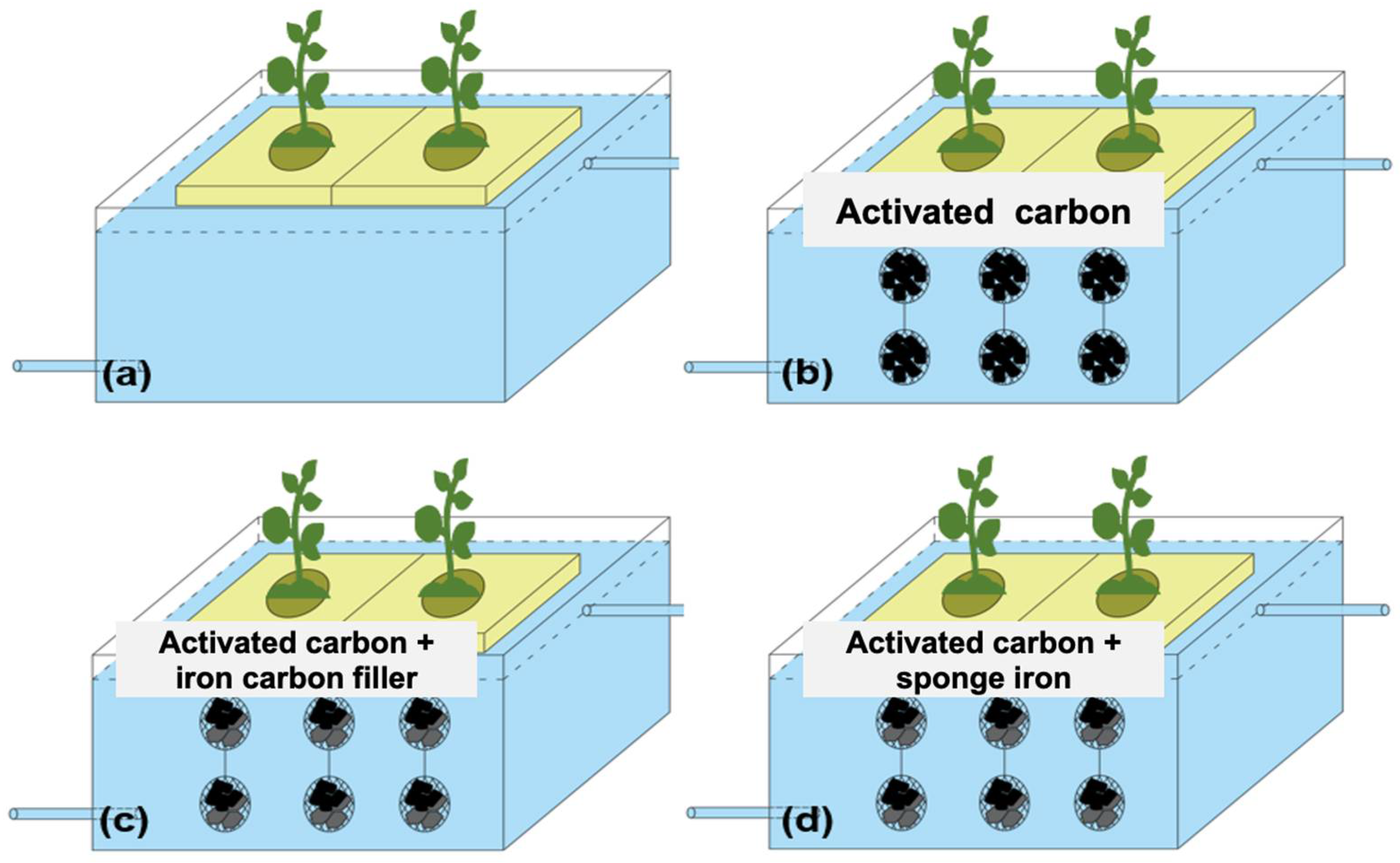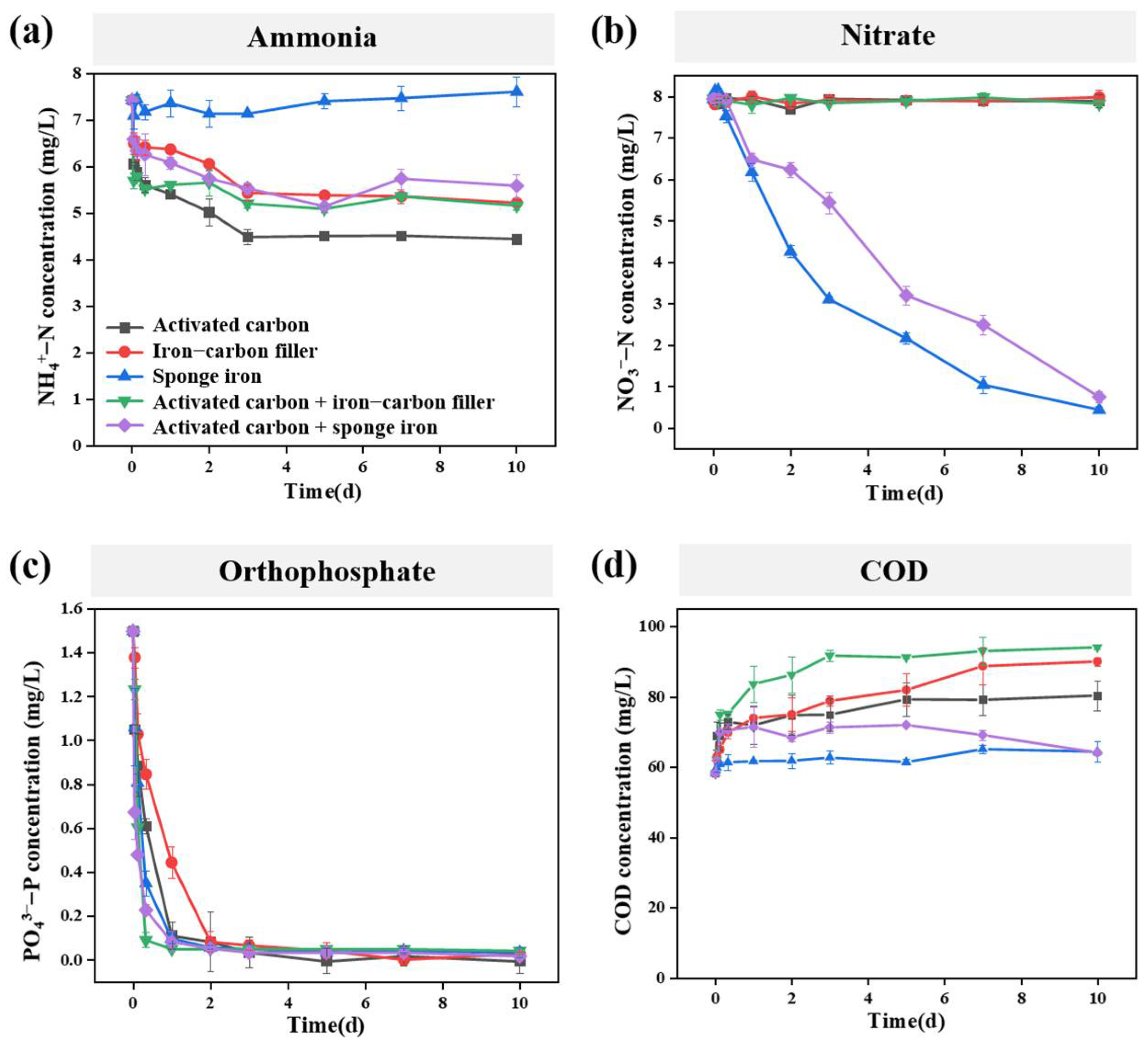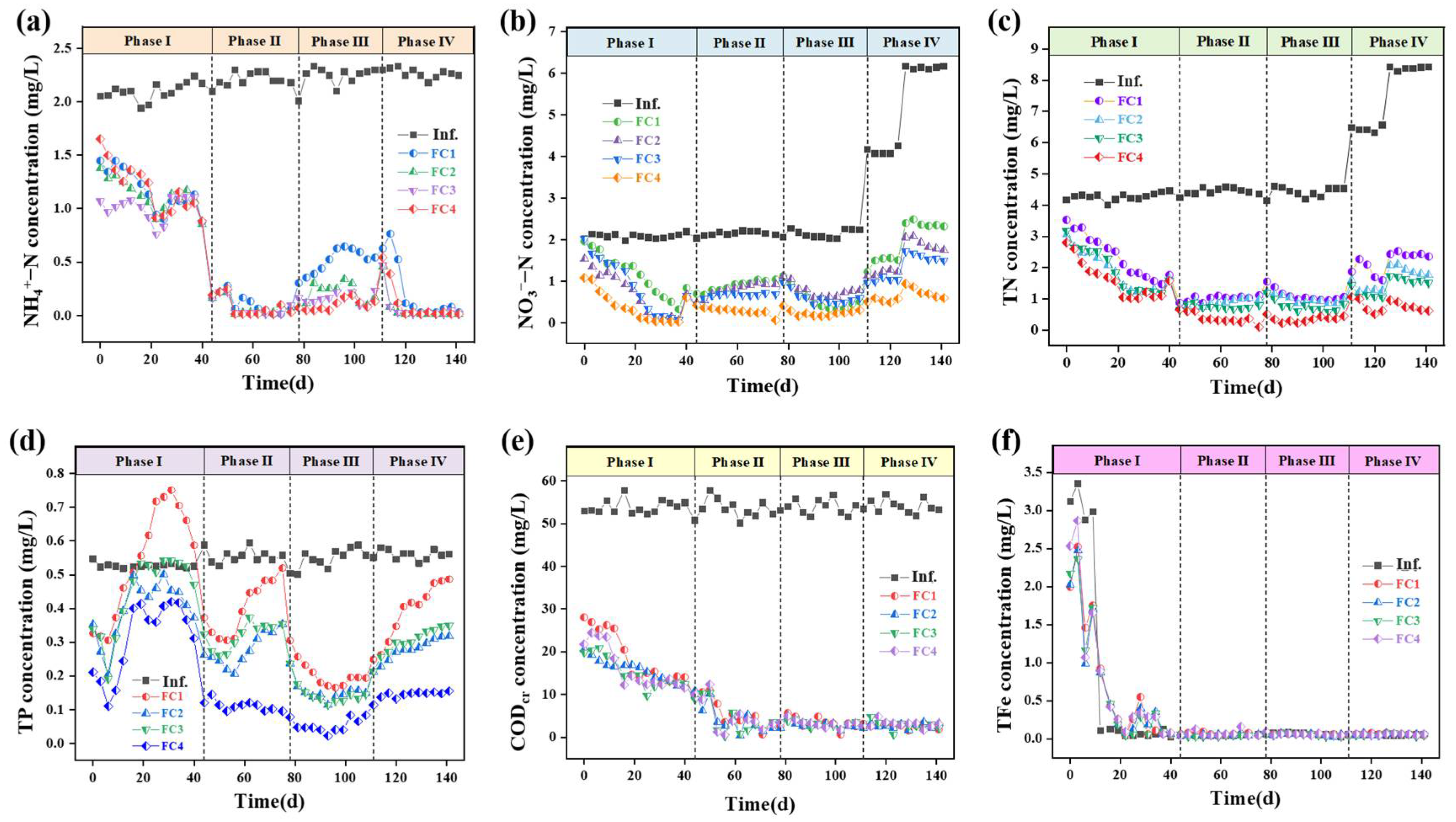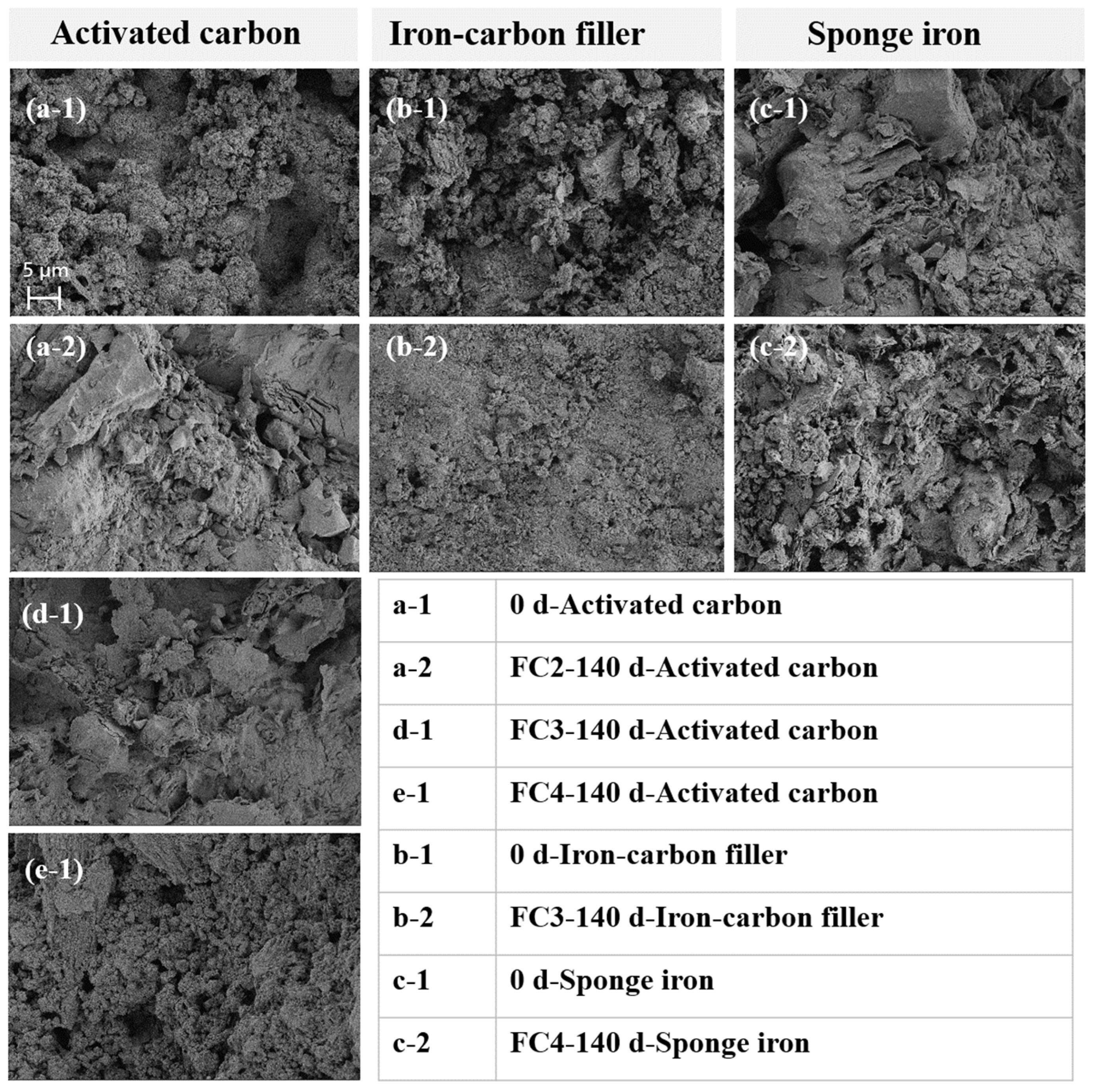Enhancing Rural Surface Water Remediation with Iron–Carbon Microelectrolysis-Strengthened Ecological Floating Beds
Abstract
:1. Introduction
2. Materials and Methods
2.1. Batch Experiment
2.2. Long-Term Operation of Ecological Floating Beds
2.3. Analytical Methods
2.4. DNA Extraction and 16S rRNA Sequencing
3. Results and Discussion
3.1. Short-Term Pollution Removal Performance of Different Filler Systems
3.2. Long-Term Removal Performance of Iron–Carbon Microelectrolysis Ecological Floating Bed
3.2.1. Nitrogen Removal
3.2.2. Phosphorus Removal
3.2.3. COD and Heavy Metal Removal
3.3. Characterization of the Filling Materials
3.4. Microbial Diversity in Iron–Carbon Microelectrolysis Floating Bed
4. Conclusions
- (i)
- All five fillers (activated carbon, iron–carbon fillers, sponge iron, activated carbon + iron–carbon fillers, and activated carbon + sponge iron) can completely remove orthophosphate, and the sponge iron filler and activated carbon + sponge iron filler system can completely remove nitrate nitrogen.
- (ii)
- Fillers are applied to an ecological floating bed, with influent concentrations of 2 mg/L of NH4+-N, 2~6 mg/L of NO3−-N, 0.5 mg/L of total phosphorus, 50 mg/L of COD, 2 mg/L of Cu2+, 4 mg/L of Zn2+, and 0.1 mg/L of Cd2+. The iron–carbon microelectrolysis (activated carbon + sponge iron filler) enhanced ecological floating bed showed superior removal efficiency for various pollutants. It achieved 95% removal of NH4+-N, 85% removal of NO3−-N, 75% removal of total phosphorus, 90% removal of COD, and 90% removal of heavy metals.
- (iii)
- Typical nitrifying bacteria of the Nitrospira, denitrifying bacteria Denitratisoma, and a variety of bacterial genera with denitrification functions (e.g., Rhodobacter, Dechloromonas, Sediminibacterium, and Novosphingobium) coexisted in the system, ensuring efficient and robust nitrogen removal performance.
Author Contributions
Funding
Institutional Review Board Statement
Informed Consent Statement
Data Availability Statement
Conflicts of Interest
References
- Ahn, S.C.; Oh, S.Y.; Cha, D.K. Enhanced reduction of nitrate by zero-valent iron at elevated temperatures. J. Hazard. Mater. 2008, 156, 17–22. [Google Scholar] [CrossRef] [PubMed]
- Alan Bojanic, H. The rapid agricultural development of Brazil in the last 20 years. EuroChoices 2017, 16, 5–10. [Google Scholar] [CrossRef]
- Reardon, T.; Echeverria, R.; Berdegué, J.; Minten, B.; Liverpool-Tasie, S.; Tschirley, D.; Zilberman, D. Rapid transformation of food systems in developing regions: Highlighting the role of agricultural research & innovations. Agric. Syst. 2019, 172, 47–59. [Google Scholar]
- Karki, B.K.; Lamichhane, K.; Joshi, L.; Raj, K.C.; Sah, M.K.; Pathak, M.; Karki, K.R. Risk assessment of heavy metals in the major surface water system of Nepal with potential remediation technologies. Environ. Chall. 2024, 14, 100865. [Google Scholar] [CrossRef]
- Md Anawar, H.; Chowdhury, R. Remediation of polluted river water by biological, chemical, ecological and engineering processes. Sustainability 2020, 12, 7017. [Google Scholar] [CrossRef]
- Samal, K.; Kar, S.; Trivedi, S. Ecological floating bed (EFB) for decontamination of polluted water bodies: Design, mechanism and performance. J. Environ. Manag. 2019, 251, 109550. [Google Scholar] [CrossRef]
- Yan, Z.; Chen, D.; Qiu, Y.; Li, D.; Yan, C.; Li, J.; Li, D.; Liu, G.; Feng, Y. Performance and mechanism of pilot-scale carbon fibers enhanced ecological floating beds for urban tail water treatment in optimized ecological floating beds water surface coverage. Bioresour. Technol. 2024, 393, 130095. [Google Scholar] [CrossRef] [PubMed]
- Kumwimba, M.N.; Li, X.; Huang, J.; Muyembe, D.K.; Dzakpasu, M.; Sanganyado, E. Performance of various fillers in ecological floating beds planted with Myriophyllum aquaticum treating municipal wastewater. Sci. Total Environ. 2022, 842, 156827. [Google Scholar] [CrossRef] [PubMed]
- Li, X.N.; Song, H.L.; Li, W.; Lu, X.W.; Nishimura, O. An integrated ecological floating-bed employing plant, freshwater clam and biofilm carrier for purification of eutrophic water. Ecol. Eng. 2010, 36, 382–390. [Google Scholar] [CrossRef]
- Lyu, J.C.; Lin, G.H.; Fan, Z.Y.; Lin, W.X.; Dai, Z. Suitable plant combinations for ecological floating beds in eutrophic subtropical coastal wetlands under different salinities: Experimental evidences. Int. J. Environ. Sci. Technol. 2020, 17, 4505–4516. [Google Scholar] [CrossRef]
- Samal, K.; Kar, S.; Trivedi, S.; Upadhyay, S. Assessing the impact of vegetation coverage ratio in a floating water treatment bed of Pistia stratiotes. SN Appl. Sci. 2021, 3, 120. [Google Scholar] [CrossRef]
- Zhu, L.; Li, Z.; Ketola, T. Biomass accumulations and nutrient uptake of plants cultivated on artificial floating beds in China’s rural area. Ecol. Eng. 2011, 37, 1460–1466. [Google Scholar] [CrossRef]
- ShahShahid, M.J.; Al-Surhanee, A.A.; Kouadri, F.; Ali, S.; Nawaz, N.; Afzal, M.; Rizwan, M.; Ali, B.; Soliman, M.H. Role of microorganisms in the remediation of wastewater in floating treatment wetlands: A review. Sustainability 2020, 12, 5559. [Google Scholar] [CrossRef]
- Sun, S.; Liu, J.; Zhang, M.; He, S. Simultaneous improving nitrogen removal and decreasing greenhouse gas emission with biofilm carriers addition in ecological floating bed. Bioresour. Technol. 2019, 292, 121944. [Google Scholar] [CrossRef] [PubMed]
- Wu, Q.; Hu, Y.; Li, S.; Peng, S.; Zhao, H. Microbial mechanisms of using enhanced ecological floating beds for eutrophic water improvement. Bioresour. Technol. 2016, 211, 451–456. [Google Scholar] [CrossRef]
- Wu, Q.; Chen, Y.; He, Y.; Cheng, Q.; Wu, Q.; Liu, Z.; Li, Y.; Yang, Z.; Tan, Y.; Yuan, Y. Enhanced nitrogen and phosphorus removal by a novel ecological floating bed integrated with three-dimensional biofilm electrode system. J. Environ. Manag. 2023, 348, 119346. [Google Scholar] [CrossRef]
- Do, T.H.; Vu, D.N.; Ngan, T.T.K. Internal Micro-electrolysis Using Fe/C Material for Pre-Treatment of Concentrated Coking Wastewater. Pol. J. Chem. Technol. 2021, 23, 41–46. [Google Scholar]
- Zheng, X.; Zhou, C.; Wu, F.; Xu, H.; Zhao, Z.; Han, Z.; Zhang, H.; Yang, S. Enhanced removal of organic, nutrients, and PFCs in the iron-carbon micro-electrolysis constructed wetlands: Mechanism and iron cycle. Chem. Eng. J. 2023, 457, 141174. [Google Scholar] [CrossRef]
- Defilippi, C.; Mukadam, M.O.A.; Nicolae, S.A.; Lees, M.R.; Giordano, C. Iron Carbide@ Carbon nanocomposites: A tool box of functional materials. Materials 2019, 12, 323. [Google Scholar] [CrossRef]
- Fdez-Sanromán, A.; Pazos, M.; Sanromán, M.A.; Rosales, E. Heterogeneous electro-Fenton system using Fe-MOF as catalyst and electrocatalyst for degradation of pharmaceuticals. Chemosphere 2023, 340, 139942. [Google Scholar] [CrossRef]
- Zhao, E.; Fan, J.; Zhang, H.; Wu, S.; Yu, Y.; Yang, Y.; Mei, S. Iron-carbon composite as flow electrode active material for highly efficient electrosorption of uranium from radioactive wastewater. Sep. Purif. Technol. 2025, 354, 128405. [Google Scholar] [CrossRef]
- GB3838-2002; Environmental Quality Standards for Surface Water. State Environmental Protection Administration of China: Beijing, China, 2002.
- Mori, H.; Maruyama, F.; Kato, H.; Toyoda, A.; Dozono, A.; Ohtsubo, Y.; Nagata, Y.; Fujiyama, A.; Tsuda, M.; Kurokawa, K. Design and experimental application of a novel non-degenerate universal primer set that amplifies prokaryotic 16S rRNA genes with a low possibility to amplify eukaryotic rRNA genes. DNA Res. 2014, 21, 217–227. [Google Scholar] [CrossRef]
- Wang, H.; Fan, Y.; Zhou, M.; Liu, J.; Li, X.; Wang, Y. Metagenomics insight into the long-term effect of ferrous ions on the mainstream anammox system. Environ. Res. 2023, 238, 117243. [Google Scholar] [CrossRef] [PubMed]
- Altmann, J.; Rehfeld, D.; Träder, K.; Sperlich, A.; Jekel, M. Combination of granular activated carbon adsorption and deep-bed filtration as a single advanced wastewater treatment step for organic micropollutant and phosphorus removal. Water Res. 2016, 92, 131–139. [Google Scholar] [CrossRef]
- Braun, J.C.; Borba, C.E.; Godinho, M.; Perondi, D.; Schontag, J.M.; Wenzel, B.M. Phosphorus adsorption in Fe-loaded activated carbon: Two-site monolayer equilibrium model and phenomenological kinetic description. Chem. Eng. J. 2019, 361, 751–763. [Google Scholar] [CrossRef]
- Li, J.; Zeng, W.; Liu, H.; Wu, Y.; Miao, H. Performances and mechanisms of simultaneous nitrate and phosphate removal in sponge iron biofilter. Bioresour. Technol. 2021, 337, 125390. [Google Scholar] [CrossRef]
- Huong, D.T.; Nguyen, V.T.; Ha, X.L.; Nguyen Thi, H.L.; Duong, T.T.; Nguyen, D.C.; Nguyen Thi, H.T. Enhanced degradation of phenolic compounds in coal gasification wastewater by methods of microelectrolysis Fe-C and anaerobic-anoxic—Oxic moving bed biofilm reactor (A2O-MBBR). Processes 2020, 8, 1258. [Google Scholar] [CrossRef]
- Iqhrammullah, M.; Saleha, S.; Maulina, F.P.; Idroes, R. Polyurethane film prepared from ball-milled algal polyol particle and activated carbon filler for NH3–N removal. Heliyon 2020, 6, E04590. [Google Scholar]
- Amarawansha, G.; Kumaragamage, D.; Flaten, D.; Zvomuya, F.; Tenuta, M. Predicting phosphorus release from anaerobic, alkaline, flooded soils. J. Environ. Qual. 2016, 45, 1452–1459. [Google Scholar] [CrossRef]
- Zafarani, H.R.; Bahrololoom, M.E.; Javidi, M.; Shariat, M.H.; Tashkhourian, J. Removal of chromate ion from aqueous solutions by sponge iron. Desalin. Water Treat. 2014, 52, 7154–7162. [Google Scholar] [CrossRef]
- Gupta, D.K.; Chatterjee, S.; Datta, S.; Veer, V.; Walther, C. Role of phosphate fertilizers in heavy metal uptake and detoxification of toxic metals. Chemosphere 2014, 108, 134–144. [Google Scholar] [CrossRef] [PubMed]
- Salgar-Chaparro, S.J.; Lepkova, K.; Pojtanabuntoeng, T.; Darwin, A.; Machuca, L.L. Nutrient level determines biofilm characteristics and subsequent impact on microbial corrosion and biocide effectiveness. Appl. Environ. Microbiol. 2020, 86, e02885-19. [Google Scholar] [CrossRef] [PubMed]
- Nagendra, H. Opposite trends in response for the Shannon and Simpson indices of landscape diversity. Appl. Geogr. 2002, 22, 175–186. [Google Scholar] [CrossRef]
- Li, Z.; Qiu, Y.; Yu, Y.; Ji, Y.; Li, H.; Liao, M.; Li, D.; Liang, D.; Liu, G.; Feng, Y. Long-term operation of cathode-enhanced ecological floating bed coupled with microbial electrochemical system for urban surface water remediation: From lab-scale research to engineering application. Water Res. 2023, 237, 119967. [Google Scholar] [CrossRef]
- Coates, J.D.; Chakraborty, R.; Lack, J.G.; O’Connor, S.M.; Cole, K.A.; Bender, K.S.; Achenbach, L.A. Anaerobic benzene oxidation coupled to nitrate reduction in pure culture by two strains of Dechloromonas. Nature 2001, 411, 1039–1043. [Google Scholar] [CrossRef]





| NH4+-N | NO3−-N | Total Phosphorus | Chemical Oxygen Demand | Cu2+ | Zn2+ | Cd2+ |
|---|---|---|---|---|---|---|
| 2 mg/L | 2/6 mg/L | 0.5 mg/L | 50 mg/L | 2 mg/L | 4 mg/L | 0.1 mg/L |
| Influent | FC1 Effluent | FC2 Effluent | FC3 Effluent | FC4 Effluent | ||
|---|---|---|---|---|---|---|
| Cu | Concentration (mg/L) | 2.15 ± 0.06 | 0.06 ± 0.02 | 0.05 ± 0.01 | 0.05 ± 0.02 | 0.03 ± 0.01 |
| Removal efficiency (%) | / | 97.29 ± 0.94 | 97.76 ± 0.57 | 97.68 ± 0.85 | 98.73 ± 0.59 | |
| Zn | Concentration (mg/L) | 4.19 ± 0.12 | 0.38 ± 0.07 | 0.14 ± 0.05 | 0.15 ± 0.07 | 0.10 ± 0.03 |
| Removal efficiency (%) | / | 91.04 ± 1.59 | 96.60 ± 1.21 | 96.48 ± 1.77 | 97.57 ± 0.66 | |
| Cd | Concentration (mg/L) | 0.10 ± 0 | 0.02 ± 0 | 0.01 ± 0 | 0.01 ± 0 | 0.01 ± 0 |
| Removal efficiency (%) | / | 82.73 ± 4.67 | 90.09 ± 3.02 | 90.00 ± 4.47 | 92.73 ± 4.67 |
| Sample | Stage | ASV | ACE | Chao | Shannon | Simpson |
|---|---|---|---|---|---|---|
| FC1 | Phase II | 627 | 627 | 627 | 4.7479 | 0.0328 |
| Phase III | 297 | 297 | 297 | 4.0747 | 0.0388 | |
| Phase IV | 318 | 318 | 318 | 3.2689 | 0.1712 | |
| FC2 | Phase II | 966 | 966 | 966 | 5.7253 | 0.0087 |
| Phase III | 773 | 773 | 773 | 5.3974 | 0.0136 | |
| Phase IV | 548 | 548 | 548 | 4.7783 | 0.0280 | |
| FC3 | Phase II | 977 | 977 | 977 | 5.6151 | 0.0130 |
| Phase III | 757 | 757 | 757 | 5.2380 | 0.0165 | |
| Phase IV | 1034 | 1034 | 1034 | 5.7556 | 0.0091 | |
| FC4 | Phase II | 933 | 933 | 933 | 5.6124 | 0.0118 |
| Phase III | 805 | 805 | 805 | 5.3811 | 0.0134 | |
| Phase IV | 814 | 814 | 814 | 5.1903 | 0.0216 |
Disclaimer/Publisher’s Note: The statements, opinions and data contained in all publications are solely those of the individual author(s) and contributor(s) and not of MDPI and/or the editor(s). MDPI and/or the editor(s) disclaim responsibility for any injury to people or property resulting from any ideas, methods, instructions or products referred to in the content. |
© 2024 by the authors. Licensee MDPI, Basel, Switzerland. This article is an open access article distributed under the terms and conditions of the Creative Commons Attribution (CC BY) license (https://creativecommons.org/licenses/by/4.0/).
Share and Cite
Wang, H.; Wang, T.; Wang, W.; Yuan, Y. Enhancing Rural Surface Water Remediation with Iron–Carbon Microelectrolysis-Strengthened Ecological Floating Beds. Sustainability 2024, 16, 7417. https://doi.org/10.3390/su16177417
Wang H, Wang T, Wang W, Yuan Y. Enhancing Rural Surface Water Remediation with Iron–Carbon Microelectrolysis-Strengthened Ecological Floating Beds. Sustainability. 2024; 16(17):7417. https://doi.org/10.3390/su16177417
Chicago/Turabian StyleWang, Han, Tianbei Wang, Weigang Wang, and Yue Yuan. 2024. "Enhancing Rural Surface Water Remediation with Iron–Carbon Microelectrolysis-Strengthened Ecological Floating Beds" Sustainability 16, no. 17: 7417. https://doi.org/10.3390/su16177417





